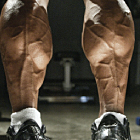 Q: I’m confused. How many muscles are in the calves? Can you explain the different calf muscles and the best exercises for training them?
Q: I’m confused. How many muscles are in the calves? Can you explain the different calf muscles and the best exercises for training them?
A: The calf is the fleshy mass at the back of the leg below the knee. It’s actually a mass of seven muscles, divided into superficial and deep groups, whose functions include extending the ankle, which points the toes.
The two main calf muscles are the meaty two-headed gastrocnemius and, beneath it, the soleus. The gastrocnemius connects the heel to the thigh bone, and the soleus connects the heel to the shin bones. The tendons of the two muscles fuse to form the Achilles tendon.
Because the soleus is underneath the gastrocnemius, most of it isn’t visible, but it still contributes significantly to calf girth. The soleus crosses the ankle joint only, but the gastrocnemius crosses the ankle and knee joints. Both muscles plantar flex the foot—point the toes—but the gastrocnemius also assists with flexion of the knee.
The calf raise is often called a “heel raise.” Confusingly, it’s also sometimes called a “toe raise” even though the toes don’t rise.
There are several types of calf raises: standing using both legs, standing using one leg at a time, seated (usually with both legs working simultaneously), and donkey style (with an assistant sitting on the bent-over bodybuilder’s hips for added resistance). Avoid the leg press machine for calf work. It offers nothing that other calf exercises don’t but can be dangerous if your feet slip out of position.
Keeping your knees straight or just slightly bent in calf work fully recruits the gastrocnemius and the soleus. Bent-knee calf work—especially the seated calf raise—reduces gastrocnemius involvement based on the extent of knee flexion. I recommend calf exercises that have the knees straight or just slightly bent—to work both the gastrocnemius and soleus simultaneously. The seated calf raise doesn’t develop anything that the other exercises don’t already develop. Instead of seated calf raises, I suggest that you put more effort into your straight-knee calf raises.
Although they’re not part of the calf muscle, there are four muscles at the front of the leg below the knee that move the toes and foot—the largest is the tibialis anterior, which runs alongside the tibia—and two muscles that extend along the lateral surface of the fibula, the peroneus longus and peroneus brevis, that lower the foot and rotate it outward.
As well as the aesthetic benefits of calf development, regular calf exercise brings health benefits. With age the return of blood to the heart through the veins decreases in efficiency. It’s prominent below the knees and may lead to varicose veins because of blood pooling and damage to the venous valves. The venous blood is moved upward through muscle contraction. Inactivity of the calves increases the difficulty of getting the venous blood to the heart. Keep your calves strong and trained.
—Stuart McRobert
www.Hardgainer.com
Editor’s note: Stuart McRobert’s first byline in IRON MAN appeared in 1981. He’s the author of the new BRAWN series, Book 1: How to Build Up to 50 Pounds of Muscle the Natural Way, available from Home Gym Warehouse (800) 447-0008 or www.Home-Gym.com.




















You must be logged in to post a comment Login